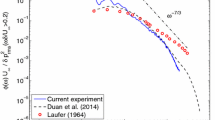Abstract
A transverse jet is injected into a supersonic model inlet flow to induce unstart. Planar laser Rayleigh scattering from condensed CO2 particles is used to visualize flow dynamics during the unstart process, while in some cases, wall pressure traces are simultaneously recorded. Studies conducted over a range of inlet configurations reveal that the presence of turbulent wall boundary layers strongly affect the unstart dynamics. It is found that relatively thick turbulent boundary layers in asymmetric wall boundary layer conditions prompt the formation of unstart shocks; in symmetric boundary conditions lead to the propagation of pseudo-shocks; and in both cases facilitate fast inlet unstart, when compared with thin, laminar boundary layers. Incident shockwaves and associated reflections are found to affect the speed of pressure disturbances. These disturbances, which induce boundary layer separation, are found to precede the formation of unstart shocks. The results confirm the importance of and need to better understand shock-boundary layer interactions in inlet unstart dynamics.















Similar content being viewed by others
References
Andreadis D (2004) Scramjet engines enabling the seamless integration of air & space operations. The Industrial Physicist, Aug/Sept 2004
Arai T, Sugiyama H, Abe F, Takahashi T, Onodera O (1990) Internal structure of pseudo-shock waves in a square duct. AIP Conf Proc 208:850–855
Ashkenas H, Sherman RS (1965) The structure and utilization of supersonic free jets in low density wind tunnels. Rarefied Gas Dyn 2:84–105
Curran ET, Murphy SNB (2000) Scramjet propulsion, progress in astronautics and aeronautics 189, AIAA Inc., USA: 183
Curran ET, Heiser WH, Pratt DT (1996) Fluid phenomena in scramjet combustion systems. Annu Rev Fluid Mech 28:323–360
Do H, Im S, Mungal MG, Cappelli MA (2010) Visualizing supersonic inlet duct unstart using planar laser Rayleigh scattering. Exp Fluids (accepted for publication) doi 10.1007/s00348-010-1028-4
Emami S, Trexler CA, Auslender AH, Weidner JP (1995) Experimental investigation of inlet-combustor isolators for a dual-mode scramjet at a Mach number of 4. NASA Technical Paper 3502
Graham RH (2002) SR-71 Blackbird. MBI Publishing Company, St. Paul, pp 27–28
Hataue I (1989) Computational study of the shock-wave/boundary-layer interaction in a duct. Fluid Dyn Res 5:217–234
Hawkins WR, Marquart EJ (1995) Two-dimensional generic inlet unstart detection at Mach 2.5–5.0. In: 6th international aerospace planes and hypersonics technologies conference, Chattanooga, TN, USA
Heiser WH, Pratt DT (1993) Hypersonic air breathing propulsion. In: AIAA education series, Washington, DC
Im S, Do H, Cappelli MA (2010) Dielectric barrier discharge control of a turbulent boundary layer in a supersonic flow. Appl Phys Lett 97:041503
Katanoda H, Matsuoka T, Matsuo K (2003) Experimental study on shock wave structures in constant-area passage of cold spray nozzle. J Thermal Sci 16:40–45
Kodera M, Tomioka S, Kanda T, Mitani T, Kobayashi K (2003) Mach 6 test of a scramjet engine with boundary-layer bleeding and two-staged fuel injection. In: 12th AIAA international space planes and hypersonic systems and technologies, Norfolk, VA, USA
Mashio S, Kurashina K, Bamba T, Okimoto S, Kaji S (2001) Unstart phenomenon due to thermal choke in scramjet module. In: AIAA/NAL-NASDA-ISAS 10th international space planes and hypersonic systems and technologies conference, Kyoto, Japan
Matsuo K, Miyazato Y, Kim H (1999) Shock train and pseudo-shock phenomena in internal gas flows. Prog Aerospace Sci 35:33–100
McDaniel KS, Edwards JR (2001) Three-dimensional simulation of thermal choking in a model scramjet combustor. In: 39th aerospace sciences meeting and exhibit, Reno, NV, USA
McRae DS, Neaves M (1994) Time accurate computation of unsteady hypersonic inlet flows with a dynamic flow adaptive mesh, Technical Report, AFRL-SR-BL-TR-98-0091
Miles RB, Lempert WR (1997) Quantitative flow visualization in unseeded flows. Annu Rev Fluid Mech 29:285–326
O’Byrne S, Doolan M, Olsen SR, Houwing AFP (2000) Analysis of transient thermal choking processes in a model scramjet engine. J Propulsion Power 16:808–814
Poggie J, Erbland PJ, Smits AJ, Miles RB (2004) Quantitative visualization of compressible turbulent shear flows using condensate-enhanced Rayleigh scattering. Exp Fluids 37:438–454
Rodi PE, Emami S, Trexler CA (1996) Unsteady pressure behavior in a ramjet/scramjet inlet. J Propulsion Power 12:486–493
Sato S, Izumikawa M, Tomioka S, Mitani T (1997) Scramjet engine test at Mach 6 flight Condition. In: 33rd AIAA/ASME/SAE/ASEE joint propulsion conference and exhibit, Seattle, WA, USA
Shimura T, Mitani T, Sakuranaka N, Izumikawa M (1998) Load oscillations caused by unstart of hypersonic wind tunnels and engines. J Propulsion Power 14:348–353
Smith SH, Mungal MG (1998) Mixing, structure and scaling of the jet in crossflow. J Fluid Mech 357:83–122
Tam C, Eklund D, Behdadnia R (2008) Influence of downstream boundary conditions on scramjet-isolator simulations. In: 26th AIAA applied aerodynamics conference, Honolulu, HI, USA
Valdivia A, Yuceil KB, Wagner JL, Clemens NT, Dolling DS (2009) Active control of supersonic inlet unstart using vortex generator jets. In: 39th fluid dynamics conference and exhibit, San Antonio, TX, USA
Wagner JL, Yuceil KB, Valdivia A, Clemens NT, Dolling DS (2008) PIV measurements of the unstart process in a supersonic inlet/isolator. In: 38th fluid dynamics conference and exhibit, Seattle, WA, USA
Wagner JL, Yuceil KB, Clemens NT (2009a) PIV Measurements of Unstart of an Inlet-Isolator Model in a Mach 5 Flow. In: 39th fluid dynamics conference and exhibit, San Antonio, TX, USA
Wagner JL, Yuceil KB, Valdivia A, Clemens NT, Dolling DS (2009b) Experimental investigation of unstart in an inlet/isolator model in Mach 5 flow. AIAA J 47:1528–1542
Wang X, Le J (2000) Computations of inlet/isolator for SCRAMjet engine. J Thermal Sci 9:334–338
Wieting AR (1976) Exploratory study of transient unstart phenomena in a three-dimensional fixed-geometry scramjet engine. NASA Technical Note: TN D-8156
Wu P, Lempert WR, Miles RB (2000) Megahertz pulse-burst laser and visualization of shock-wave/boundary-layer interaction. AIAA J 38:672–679
Acknowledgments
This work is sponsored by the Department of Energy sponsored Predictive Science Academic Alliance Program (PSAAP) at Stanford University.
Author information
Authors and Affiliations
Corresponding author
Rights and permissions
About this article
Cite this article
Do, H., Im, Sk., Mungal, M.G. et al. The influence of boundary layers on supersonic inlet flow unstart induced by mass injection. Exp Fluids 51, 679–691 (2011). https://doi.org/10.1007/s00348-011-1077-3
Received:
Revised:
Accepted:
Published:
Issue Date:
DOI: https://doi.org/10.1007/s00348-011-1077-3




